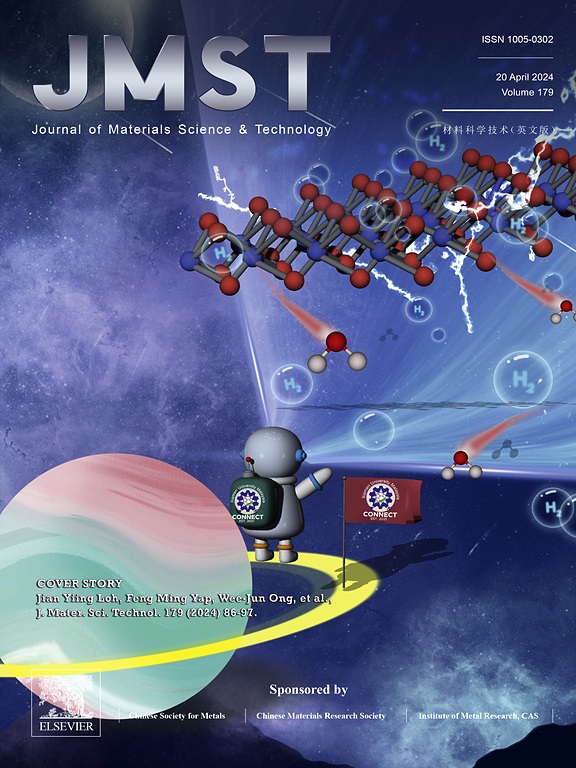基于宏观变形和晶体塑性建模的钛合金多向锻造粗晶非均匀细化模拟
IF 14.3
1区 材料科学
Q1 MATERIALS SCIENCE, MULTIDISCIPLINARY
引用次数: 0
摘要
钛合金多向锻造粗晶破碎机理复杂,直接影响一次热加工工艺的优化与控制。本研究对β相铸态Ti-6554合金进行了MDF实验,通过宏观和微观变形建模模拟了循环多向压缩过程中的非均匀变形。结果表明:摩擦和表面冷却导致坯料边缘应变和拉应力集中较低,形成混合晶粒组织;相反,坯料中心的高应变和三轴压应力有利于晶粒的均匀细化。经过14次压缩和4次中间再加热,粗晶从2-5 mm细化到0.25-0.50 mm,实现了不同区域晶粒尺寸的均匀化。首次在显微镜下观察了不同形态晶粒在多向压缩过程中的取向演化过程。由于局部应变的积累,柱状晶粒比等轴晶粒更容易被细分。在累积压缩作用下,晶粒取向逐渐由均匀转向随机,驱动连续动态再结晶(CDRX)。滑移系统的相互作用和集中的错取向导致过渡带和剪切带的形成和扩展,导致以穿晶细分CDRX为主的颗粒破碎。光滑晶界在多次经过后转变为锯齿形晶界,为不连续动态再结晶(DDRX)提供了额外的形核位点,促进了边界扩展。多种DRX机制的相互作用是晶粒细化的根本原因。本研究阐明了在增大锻造应变下细化和均匀化毫米级粗晶的原理,为铸态β钛合金初级热加工技术的发展提供了有价值的见解。本文章由计算机程序翻译,如有差异,请以英文原文为准。

Coarse grain non-uniform refinement simulation in multi-directional forging of titanium alloys based on macro-deformation and crystal plasticity modelling
The complex grain fragmentation mechanisms of coarse grains in titanium alloys under multi-directional forging (MDF) directly influence the optimization and control of primary hot working processes. This study conducted MDF experiments on β-phase as-cast Ti-6554 alloy and simulated non-uniform deformation during cyclic multi-directional compression through macro- and micro-deformation modeling. The results revealed that friction and surface cooling caused low strain and tensile stress concentration at billet edges, leading to mixed grain structures. In contrast, high strain and triaxial compressive stress at billet centers facilitated uniform grain refinement. After 14 compressions and 4 intermediate reheating processes, coarse grains of the billet were refined from 2–5 mm to 0.25–0.50 mm, achieving uniform grain sizes across different regions. For the first time, the orientation evolution of grains with different morphologies during multi-directional compressions was visualized microscopically. Columnar grains were found to be more easily subdivided than equiaxed grains due to local strain accumulation. Under cumulative compressions, grain orientations gradually rotated from uniform to random, driving continuous dynamic recrystallization (CDRX). Slip system interactions and concentrated misorientation led to the formation and extension of transition and shear bands, inducing grain fragmentation dominated by transgranular subdivided CDRX. Smooth grain boundaries transformed into serrated ones after multiple passes, providing additional nucleation sites for discontinuous dynamic recrystallization (DDRX) and facilitating boundary expand CDRX. The interaction of diverse DRX mechanisms was the fundamental cause of grain refinement. This study clarified the principles of refining and homogenizing millimeter-grade coarse grains under increasing forging strain, offering valuable insights for the development of primary hot processing techniques for as-cast β titanium alloys.
求助全文
通过发布文献求助,成功后即可免费获取论文全文。
去求助
来源期刊

Journal of Materials Science & Technology
工程技术-材料科学:综合
CiteScore
20.00
自引率
11.00%
发文量
995
审稿时长
13 days
期刊介绍:
Journal of Materials Science & Technology strives to promote global collaboration in the field of materials science and technology. It primarily publishes original research papers, invited review articles, letters, research notes, and summaries of scientific achievements. The journal covers a wide range of materials science and technology topics, including metallic materials, inorganic nonmetallic materials, and composite materials.
 求助内容:
求助内容: 应助结果提醒方式:
应助结果提醒方式:


